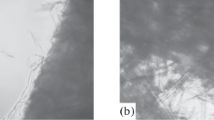Summary
Lysolecithin has been used to induce cell fusion between two metabolically deficient mouse fibroblast lines, A9 and B82. Attempted fusion in suspension led to excessive cell clumping and complete loss of viability. Addition of lysolecithin solutions to confluent monolyers caused extensive detachment of cells from glass or plastic surfaces. At higher levels of lysolecithin few cells survived. When the conditions were controlled (50 to 250 μg per ml for up to 20 min), extensive polykaryocyte formation was observed. In the presence of selective medium (HAT) colonies of hybrid cells grew and a series of cell strains were isolated. The presence of inosinic acid pyrophosphorylase (absent in A9 cells) was demonstrated in the hybrid cells which were shown to have almost double the cell volume of the parent A9 and B82 cells. Unlike the parent cell lines, the hybrid cells grew well in the presence of HAT both as monolayers and in suspension.
Similar content being viewed by others
References
Davidson, R., and B. Ephrussi. 1970. Factors influencing the effective mating rate of mammalian cells. Exp. Cell Res. 61: 221–226.
Harris, H., and J. F. Watkins. 1965. Hybrid cells derived from mouse and man; artificial heterokaryons of mammalian cells from different species. Nature (Lond.) 205: 640–646.
Okada, Y. 1962. Analysis of giant polynuclear cell formation caused by HVJ virus from Ehrlich's ascites tumor cells. Exp. Cell Res. 26: 98–107.
Howell, J. I., and J. A. Lucy. 1969. Cell fusion induced by lysolecithin. FEBS Lett. 4: 147–150.
Poole, A. R., J. I. Howell, and J. A. Lucy. 1970. Lysolecithin and cell fusion. Nature (Lond.) 227: 810–814.
Croce, C. M., W. Sawicki, D. Kritchevsky, and H. Koprowski. 1971. Induction of homokaryocyte, heterokaryocyte and hybrid formation by lysolecithin. Exp. Cell Res. 67: 427–435.
Littlefield, J. W. 1966. The use of drug-resistant markers to study the hybridization of mouse fibroblasts. Exp. Cell Res. 41: 190–196.
Littlefield, J. W. 1963. The inosinic acid pyrophosphorylase activity of mouse fibroblasts partially resistant to 8-azaguanine. Proc. Natl. Acad. Sci. U.S.A. 50: 568–576.
Littlefield, J. W. 1965. Studies on thymidine kinase in cultured mouse fibroblasts. Biochim. Biophys. Acta 95: 14–22.
Davidson, R. L., and B. Ephrussi. 1965. A selective system for the isolation of hybrids between L-cells and normal cells. Nature (Lond.) 206: 1170–1171.
DeMaggio, A. E. 1971. Ferns as a model system for studying polyploidy and gene dosage effects. Bioscience 21: 313–322.
Harris, M. 1971. Polyploid series of mammalian cells. Exp. Cell Res. 66: 329–336.
Author information
Authors and Affiliations
Rights and permissions
About this article
Cite this article
Keay, L., Weiss, S.A., Cirulis, N. et al. Lysolecithin-induced fusion of fibroblasts. In Vitro 8, 19–25 (1972). https://doi.org/10.1007/BF02617939
Issue Date:
DOI: https://doi.org/10.1007/BF02617939




